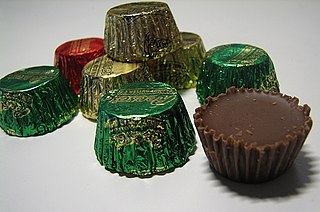
A chocolate chip cookie is a drop cookie that features chocolate chips or chocolate morsels as its distinguishing ingredient. Chocolate chip cookies are claimed to have originated in the United States in 1938, when Ruth Graves Wakefield chopped up a Nestlé semi-sweet chocolate bar and added the chopped chocolate to a cookie recipe; however, historical recipes for grated or chopped chocolate cookies exist prior to 1938 by various other authors.

A chocolate bar is a confection containing chocolate, which may also contain layerings or mixtures that include nuts, fruit, caramel, nougat, and wafers. A flat, easily breakable, chocolate bar is also called a tablet. In some varieties of English and food labeling standards, the term chocolate bar is reserved for bars of solid chocolate, with candy bar used for products with additional ingredients.

Snickers is a chocolate bar consisting of nougat topped with caramel and peanuts, all encased in milk chocolate. The bars are made by the American company Mars Inc. The annual global sales of Snickers is over $380 million, and it is widely considered the bestselling candy bar in the world.

M&M's are color-varied sugar-coated dragée chocolate confectionery, each of which has the letter "m" printed in lower case in white on one side, consisting of a candy shell surrounding a filling which varies depending upon the variety of M&M's. The original candy has a semi-sweet chocolate filling which, upon introduction of other variations, was branded as the "plain, normal" variety. Peanut M&M's, which feature a peanut coated in milk chocolate, and finally a candy shell, were the first variation to be introduced, and they remain a regular variety. Numerous other variations have been introduced, some of which are regular widespread varieties while others are limited in duration or geographic availability. M&M's are the flagship product of the Mars Wrigley Confectionery division of Mars Inc..

Planters Nut & Chocolate Company is an American snack food company now owned by Hormel Foods. Planters is best known for its processed nuts and for the Mr. Peanut icon that symbolizes them. Mr. Peanut was created by grade schooler Antonio Gentile for a 1916 contest to design the company's brand icon. The design was modified by a commercial artist and has continued to change over the years.

The Heath bar is a candy bar made of toffee, almonds, and milk chocolate, first manufactured by the Heath Brothers Confectionery in 1928. The Heath bar has been manufactured and distributed by Hershey since its acquisition of the Leaf International North American confectionery operations late in 1996.
Butterfinger is a candy bar manufactured by the Ferrara Candy Company, a subsidiary of Ferrero. It consists of a layered crisp peanut butter core covered in a "chocolatey" coating. It was invented by Otto Schnering of the Curtiss Candy Company in 1923. A popularity contest chose the name.

A peanut butter cup is a molded chocolate with a peanut butter filling. Peanut butter cups are one of the most popular kinds of candy in America. They can be made at home, but like most candies, they are commonly mass-produced. They may also be available in candy shops, produced by local or regional candymakers.

Reese's Peanut Butter Cups are an American candy by the Hershey Company consisting of a peanut butter filling encased in chocolate. They were created on November 15, 1928, by H. B. Reese, a former dairy farmer and shipping foreman for Milton S. Hershey. Reese was let go from his job with Hershey when the Round Barn which he managed was shut down for cost-saving measures. He subsequently decided to start his own candy business. Reese's are a top-selling candy brand worldwide, with $3.1 billion in annual sales.

Clodhoppers are crunchy, fudge-covered graham clusters. They were originally discovered and marketed by the Kraves Candy Co., located in Winnipeg, Manitoba, Canada. In 2006, the brand and recipes were sold to Brookside Foods, who were in turn sold to Hershey's in 2011.

Reese's Take 5 is a candy bar that was released by The Hershey Company in December 2004. The original name of the candy bar was TAKE5 but common usage among consumers added a space. In June 2019, when the candy bar became part of the Reese's family, the name was officially changed to Reese's Take 5.
Mr. Big is the largest sized chocolate bar produced by Cadbury in Canada, hence the name. The standard bar is made of a layered vanilla wafer biscuit coated in caramel, and rice crisps; covered in a chocolate coating. The bar is the length of two "standard"-sized bars – around 20 centimetres long. Additional varieties include Mr. Chew Big, Mr. Big Fudge, and Mr. Big with Maple.

William Neilson Dairy Limited is a Canadian dairy company owned by Saputo Inc. The company is based in Toronto, Ontario. In the United States, its products are sold under the name Neilson.
The Clark Bar is a candy bar consisting of a crispy peanut butter/spun taffy core and coated in milk chocolate. It was introduced in 1917 by David L. Clark and was popular during and after both World Wars. It was the first American "combination" candy bar to achieve nationwide success. Two similar candy bars followed the Clark Bar, the Butterfinger bar (1923) made by the Curtiss Candy Company and the 5th Avenue bar (1936) created by Luden's.
Unreal Brands is an American manufacturer of confectionery and other food products without artificial flavors, color and other non-food additives.
The Cadbury chocolate factory is a five-story building located on Gladstone Avenue in Toronto. It was constructed by William Neilson in 1906 and produces all Cadbury's products sold in Canada.











